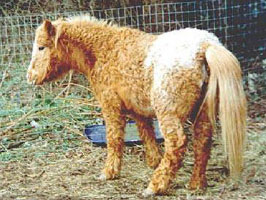ARCHIVE EQUINE NEWS STORIES
| Current news is available at TheHorsePortal.ca, Equine Guelph's online learning platform for practical, quick learning. Given the vast amount of information on horse health and welfare, Equine Guelph has archived its past news articles from 2002-2020. They are listed below, along with a search function available to find specific healthcare topics. | |
Delayed Shedding? Laminitis? - Is your senior horse challenged with a metabolic issue?May 2018
Story: Jackie Bellamy-Zions
 Ah Spring; when countless materials are covered in shedding horse hair including your clothes, car, perhaps even your couch if you don’t change out of barn clothes immediately when you get home. But what if you are not covered in your horses shedding coat? Delayed shedding or regional hypertrichosis can be early warning signs of Pituitary Pars Intermedia Dysfunction (PPID) – a metabolic condition that suppresses the immune system when high cortisol levels increase blood sugar levels. Look for abnormal hair coat including patches of long hair on the legs, wavy hair on the neck, changes in coat colour or shedding patterns and unusual whisker growth. Equine Guelph’s Senior Horse Challenge healthcare tool contains useful resources to practice identifying metabolic issues.
Ah Spring; when countless materials are covered in shedding horse hair including your clothes, car, perhaps even your couch if you don’t change out of barn clothes immediately when you get home. But what if you are not covered in your horses shedding coat? Delayed shedding or regional hypertrichosis can be early warning signs of Pituitary Pars Intermedia Dysfunction (PPID) – a metabolic condition that suppresses the immune system when high cortisol levels increase blood sugar levels. Look for abnormal hair coat including patches of long hair on the legs, wavy hair on the neck, changes in coat colour or shedding patterns and unusual whisker growth. Equine Guelph’s Senior Horse Challenge healthcare tool contains useful resources to practice identifying metabolic issues.
Did you know horses seen for laminitis have frequently been found to have PPID or Equine Metabolic Syndrome (EMS)? Laminitis can be a sign of both metabolic issues yet it is often treated without identifying the underlying cause.
There is a fair bit of confusion in the horse world over mixing up PPID and EMS as they share many of the same clinical signs. Horses with PPID may also have some of the features of EMS. Equine Metabolic Syndrome had many previous names: peripheral Cushing’s Syndrome, pseudo Cushing’s syndrome, hypothyroidism, and insulin resistance syndrome.
Horses with EMS do not display hypertrichosis (excessive hair growth) or delayed shedding. New research studies are investigating changes in gut microflora as another possible early warning sign of EMS. PPID cases are more common in horses over 15 where EMS tends to be seen in horses over 5 years of age. Laminitis and obesity are often the first clues in identifying both disorders. Working with a veterinarian who can perform diagnostics is necessary to conclude which disorder you are dealing with and determine the best treatment options. Early warning signs can be subtle and of course early diagnosis is important.
“Every year Boehringer Ingelheim sponsors a PPID testing campaign in partnership with Animal Health Laboratory in Guelph,” says Guillaume Cloutier, DVM, Boehringer Ingelheim Animal Health. “In 2017, out of the 442 horses that were tested, 273 (62%) had a positive result for PPID.”
To learn more about detecting early warning signs for metabolic issues and other important factors in maintaining health as your horse ages, visit Equine Guelph’s Senior Horse Challenge healthcare tool, kindly sponsored by Boehringer Ingelheim.